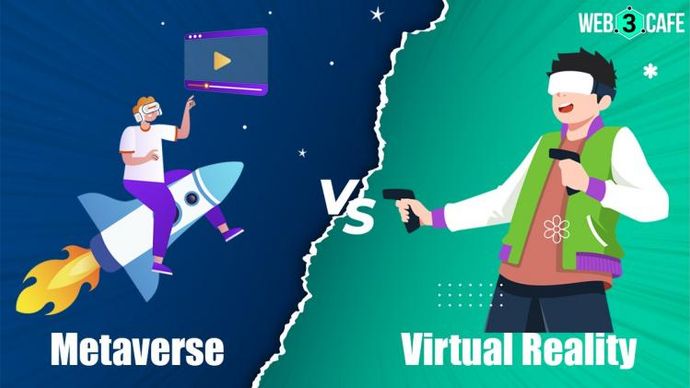Metaverse vs Virtual Reality: Knowing the Differences
Metaverse and VR offer virtual experiences, but are not identical.

Highlights
- Virtual reality and the metaverse differ, but both offer virtual experiences
- Tech companies like Microsoft, Google, Apple, etc. are working on their own metaverses
- The metaverse offers many opportunities for innovation
In the modern tech era, the metaverse and virtual reality are two fascinating technologies that are quickly developing and changing the way people connect with one another. But the question arises: Are these technologies similar to one another or do they significantly differ from one another?
Virtual reality and the metaverse have significant differences, yet because both offer consumers a virtual experience, many people mistakenly believe that they are nearly identical.
Let's first understand the fundamental definitions of the metaverse and virtual reality before going into their distinctions.
All about the metaverse
The metaverse is a three-dimensional, open, shared online environment that enables connections between individuals from every aspect of life. Matthew Ball, a writer and investor, provides the following thorough definition of the metaverse in his book, The Metaverse: And How It Will Revolutionise Everything:
“A massively scaled and interoperable network of real-time rendered 3D virtual worlds that can be experienced synchronously and persistently by an effectively unlimited number of users with an individual sense of presence, and with continuity of data, such as identity, history, entitlements, objects, communications, and payments.”
The idea was first presented in 1992, in a science fiction book, titled 'Snow Crash’ by author Neal Stephenson. At first, the idea was thought to be just science fiction, but it now seems like it may become a reality in the near future. Nearly every major tech company is working on its own metaverse, including Nvidia, Microsoft, Google, Apple, Steam/Valve, and Meta, etc.
Applications
Users in the metaverse can play games, go to concerts, have 3D meetings, customise avatars, and have a variety of other experiences. In addition to gaming and social media, the metaverse also has other systems, including decentralised governments, digital identities, and economies.
What exactly is virtual reality?
The definitions of the words ‘virtual’ and ‘reality’ are used to develop the notion of virtual reality. ‘Virtual’ refers to something that is close, and ‘reality’ is what we as individuals experience every day. So, the term ‘virtual reality’ or VR strongly implies ‘close reality.’
VR applications
Virtual Reality is a limited form of technology where users can only participate in the virtual adventures provided by their VR service provider, where people own the shared virtual environment. The presence of VR is created by wearing a VR headset or goggles , and there are numerous models available for this purpose, including the Oculus Rift, Samsung Gear VR, Google Daydream View, and Google Cardboard. These headsets provide each eye with video while blocking out the outside environment to provide a deeper experience.
Understanding the differences: Metaverse vs Virtual Reality
The most significant differences between the metaverse and virtual reality are summarised below.
- Technological differences between the two
The metaverse and virtual reality are both fantastic technological advances. However, Virtual reality has limitations as compared to metaverse and can only go so far because it is all about taking virtual journeys.
Virtual reality appears to be about playing around in virtual environments and simulating things. The metaverse, on the other hand, is an expansive, unrestricted ecosystem of the internet that has been since it was created using a variety of technologies, including augmented and virtual reality. It is a fully functioning digital environment over which you have control and can make improvements.
- The persistent capacity of the metaverse and VR
Although virtual reality is great for experiences, it is useless if you turn it off. The metaverse, on the other hand, uses technologies like augmented reality and others to continuously move and merge real and virtual experiences, giving you a realistic, real-life sense in a virtual style that is constantly available and has real-life outcomes in a variety of formats.
- Accessibility between the metaverse and VR
The accessibility of the metaverse is still being worked on by numerous tech giants. Yet, there are several companies, including Facebook, Sony, HTC, Valve, and many others, that offer virtual reality experiences and a variety of VR equipment. Oculus Home, SteamVR, and Viveport are the platforms that have been developed to allow users to interact with the virtual world.
Conclusion
In the metaverse, there are numerous opportunities for further innovation. It's important to remember that the metaverse typically incorporates a much more extensive system than any conventional virtual world. While VR is one of the key technologies for the growth of the metaverse, it only has a few functionalities. In the metaverse, there are countless possibilities still to be discovered.
